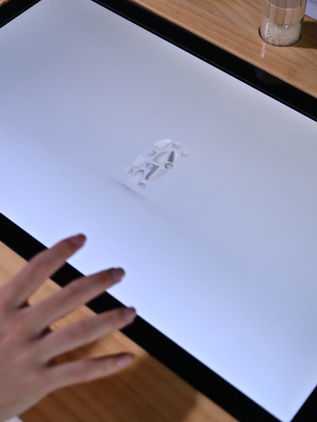
Rice Journey
Rice Journey is a multisensory, table-based installation that transforms the act of waiting for a meal into a tactile, visual, and cultural experience. Designed in the form of a wooden dining table, the interface invites participants to explore the diversity of Chinese rice traditions through sight, touch, sound, and motion.
Visitors are invited to open a side drawer to discover four glass jars filled with different types of rice. By selecting and inserting a jar into the tabletop sensor area, participants activate a digital experience that visualizes the origin and properties of the chosen rice. Using hand gestures, they then simulate traditional Chinese cooking techniques, guided by animations on an embedded screen. The installation proposes a new form of dining: one where cultural understanding and embodied interaction enrich the act of eating.
Year of Creation
Type
2022
Multisensory Table Installation
Materials
Custom wooden dining table, embedded screen, RFID sensor, Leap Motion controller, four rice-filled glass jars with NFC tags

An Educational Tangible Interface

Four Main Type of Rice in China Culinary Culture

Background Research
Concept: Beyond Eating
At its core, Rice Journey is about reclaiming dining as a space of cultural transmission. Rather than viewing rice as a neutral staple, the installation reveals it as a carrier of regional identity, history, and practice.
Each jar represents one of the four major rice cultures in China:
-
Jingmi (粳米) – the polished rice of central and eastern China (Jiangsu, Zhejiang, Shanghai)
-
Xianmi (籼米) – long-grain rice common in the humid south
-
Nuomi (糯米) – glutinous rice used in northern ceremonial and everyday dishes
-
Zhenzhumi (珍珠米) – small-grained pearl rice from the southwest, often associated with mountainous regions
The act of touching, shaking, and observing the rice invites participants to reconsider how knowledge of food begins—not in taste, but in the hand and the eye. By embedding interaction into the table itself, Rice Journey reframes the table as a site of attention, learning, and reflection. It asks: what if the waiting moment before a meal could become a moment of discovery?

3D Model of Four Types of Rice

Four Type of Rice

Design Drawing of the Table

The Final Product of the Design
Design & Fabrication
The physical structure of Bodily Nature is composed of a suspended circular ring wrapped in mirrored vines and translucent panels. Designed to evoke both ritualistic forms and botanical growth, the ring serves as both a visual focal point and a spatial frame for interaction. It was fabricated using laser-cut acrylic diffusers, hand-shaped vine elements, and a modular aluminum frame to ensure lightweight strength and balance during suspension. The structural design emphasizes openness and permeability, allowing participants to step inside and experience the installation from within—both visually and sonically.
Rice Journey Experience
Embodied Interface
Rice Journey is not a tool or an app—it is a physical conversation. Every design decision, from the ergonomics of the table height to the texture of the jars, was guided by iterative user testing to ensure comfort and natural flow. The experience is meant to be exploratory, slow, and sensorial—echoing the rhythm of real cooking and shared meals.
By shifting the focus from food as outcome to food as culture, the work invites people to linger at the threshold between nourishment and knowledge.










